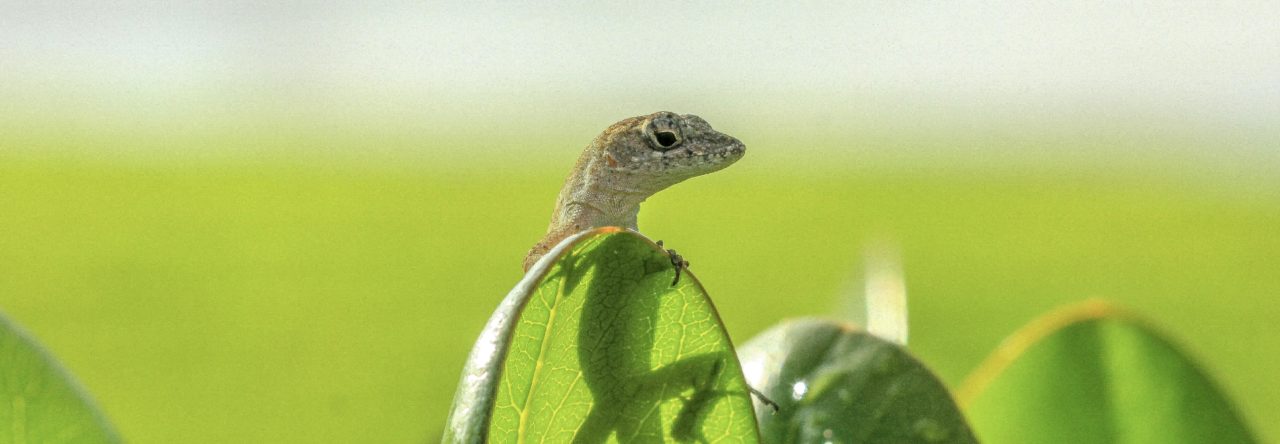I took the photo above while out on nocturnal hunt for twig anoles in the Sierra de Bahoruco (a mountain range in the southwest Dominican Republic). Searching for twig anoles generally involves lots of hours spent scanning vines and twigs for narrow lizard profiles. Can you find the twig anole in this image (click on the image for a larger version)?
Anoles fall prey to a variety of animals. Here, a male brown anole, A. sagrei, is being subdued and swallowed by a black racer (Coluber constrictor). Casey Gilman and I heard the two animals struggling while working on spoils islands in Mosquito Lagoon.
All of these islands have Florida-native green anoles (Anolis carolinensis) on them. Most islands also have the brown anole, an invasive species. In his Anolis Newsletter VI contribution, Nathan Turnbough found a non-random association between brown anole presence and racer presence on Mosquito Lagoon islands. He concluded that high densities of brown anoles support more racers.
Green anoles tend to become more arboreal in the presence of brown anoles. It is generally thought that direct interactions between the species, like resource competition or intraguild predation, cause this habitat shift. However, by increasing the density of predators, brown anoles may also indirectly affect green anole habitat use. The habitat shift may result from green anoles getting out of the way of ground-foraging racers – an escape to enemy free space.
Anoles only lay one egg at a time. This penurious habit has been speculated to result from their arboreal lifestyle—because they spend so much time running around on vertical surfaces, they can’t afford to be weighed down by a big clutch of eggs. Reasonable enough, but is there any evidence that carrying eggs has any cost to female anoles? In a recent study in Ethology, Johnson et al. find that in A. carolinensis, as the mass of the egg increased, display behavior and movement rates decreased, suggesting that females are less active as they become more gravid. Whether this is inactivity results because females are more vulnerable to predators or for other reasons is not known.
This video was filmed near Bayahibe in the Dominican Republic in the summer of 2010. You’ll probably enjoy this video more with the sound turned off, I get pretty excited providing color commentary and use at least one naughty word.
Can someone explain this to me? Have anoles gotten commercially big when I wasn’t looking?
This post is for those of you who might not be regular readers of Amphibia-Reptilia. Last summer, Joyce et al. reported on habitat mediated variation in size, population density and mating system in the St. Eustatius (Lesser Antilles) anole A. schwartzi. Joyce et al. quantified body size, density, and frequency of display behaviors in populations of A. schwartzi occupying habitats with and without available rocky substrates. They found denser populations of larger individuals that tend to display more frequently occupying rocky substrates. Their results suggest that the mating system and intensity of competition for mates varies among habitats in a predictable manner. This article is another in a long string of valuable contributions from Bob Powell’s REU courses.
Just following through on my promise to post more tongue extension photos. This one is of two male A. stratulus in Puerto Rico engaging in a vigorous back and forth display. Similar to the results reported by Schwenk and Meyer, this exchange occurred in the later stages of an encounter and was followed by direct physical aggression between the two males pictured.
Anole displays can get pretty intense. My favorite feature of a really vigorous display is the lingual extension, a move that reminds me of Michael Jordan driving the lane for a dunk. Although I’ve illustrated this phenomenon with a photo of Anolis distichus, I’ve seen many species of anoles using this move during really intense displays. I’ll try to post more photos in the coming weeks.
The editors of Anole Annals were saddened to learn that an Islamist insurgent group in Somalia has taken the name of our favorite lizard. According to Voice of America News, the Anole fighters and their ally, the Ras Kamboni Brigade, are among the “clan-based factions of Hizbul Islam, a fundamentalist nationalist opposition group that formed an alliance with al-Shabab earlier this year to oppose the U.N.-backed government in Mogadishu.” Other news outlets confirm the existence of the anole group, but offer up few additional details [1, 2]. The anole fighters do not appear to have taken their name due to any perceived affiliation between Anolis lizards and the fundamentalist Islamic insurgency in Somalia (it seems more likely that group’s name is derived from an affiliation with the town of Anole in coastal Somalia). Nevertheless, we at Anole Annals are speaking out today to denounce exploitation of the anole name for violent purposes and to express our support for a non-violent resolution to the ongoing conflict in Somalia.








